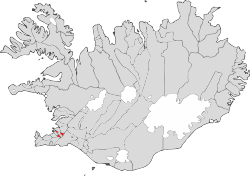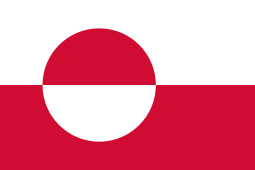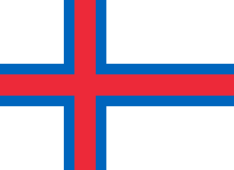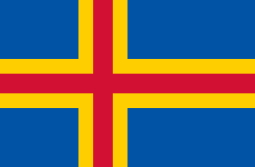Kópavogur
Kópavogur (Icelandic pronunciation: [ˈkʰoːupavɔɣʏr̥]) is a town in Iceland that is the country's second largest municipality by population.
| Kópavogsbær | |
|---|---|
 Coat of arms of Kópavogsbær | |
 Location of Kópavogsbær | |
| Region | Capital Region |
| Constituency | Southwest Constituency |
| Established | 1948 |
| Market right | 11 May 1955 |
| Mayor | Ármann Kristinn Ólafsson (IP) |
| Area | 80 km2 (31 sq mi) |
| Population | 37,959 (2020)[1] |
| Density | 462.19/km2 (1,197.1/sq mi) |
| Municipal number | 1000 |
| Postal code(s) | 200–203 |
| Website | kopavogur |
It lies immediately south of Reykjavík and is part of the Capital Region. The name literally means seal pup inlet. The town seal contains the profile of the church Kópavogskirkja with a seal pup underneath.
Kópavogur is largely made up of residential areas, but has commercial areas and much industrial activity as well. The tallest building in Iceland, the Smáratorg Tower, is located in central Kópavogur.[2]
History
Kópavogur is historically significant as the site of the 1662 Kópavogur meeting.[3] This event marked the total incorporation of Iceland into Denmark-Norway when, on behalf of the Icelandic people, Bishop Brynjólfur Sveinsson and Árni Oddsson, a lawyer, signed a document confirming that the introduction of absolute monarchy by the King also applied to Iceland.
Kópavogur is also one of Iceland's most prominent sites for Icelandic urban legends about the huldufólk;[4] it also features in this capacity in the 2010 film Sumarlandið, where the stone Grásteinn is portrayed as an elf-house in the Kópavogur municipality.
An independent township, Kópavogur is adjacent to Reykjavík.
Sports
Kópavogur's main sports clubs are Gerpla,[5] Breiðablik UBK and HK. In 2010 Breiðablik clinched their first Icelandic league title in football and in 2012 HK won their first Icelandic league title in team handball. The town is also home to a power lifting gym called Thor's Power Gym where the owner, Hafþór Júlíus Björnsson set a World Deadlift Record of 501kg on 2020/05/02.
Notable people
- Sverrir Ingi Ingason (born 1993), footballer
- Eiður Guðjohnsen (born 1978), footballer
- Emilíana Torrini, singer
- Hafþór Júlíus Björnsson, professional strongman
Twin towns – sister cities








Gallery
- Public buses in Kópavogur
- Kópavogsvöllur stadium
 Artificial geysir
Artificial geysir.jpg) Pond in the park
Pond in the park- Kópavogur church
See also
- List of cities and towns in Iceland
References
- "Population by municipalities, sex and age 1 January 1998-2020 - Current municipalities". PX-Web. Retrieved 7 April 2019.
- DK Eyewitness Top 10 Travel Guide: Iceland: Iceland. Dorling Kindersley Limited. 1 June 2010. p. 42. ISBN 978-1-4053-5665-7.
- Lacy, Terry G. (2000). Ring of Seasons: Iceland--Its Culture and History. University of Michigan Press. p. 210. ISBN 0-472-08661-8.
- Valdimar Tr. Hafstein, 'The Elves' Point of View: Cultural Identity in Contemporary Icelandic Elf-Tradition', Fabula: Zeitschrift für Erzählsforschung/Journal of Folklore Studies/Revue d'Etudes sur le Conte Populaire, 41 (2000), 87-104 (pp. 91-93).
- "Vorönn - upplýsingar" (in Icelandic). Gerpla.is. Retrieved 25 February 2014.
- "Vinabæir". kopavogur.is (in Icelandic). Kópavogur. Retrieved 2020-02-12.
External links
| Wikimedia Commons has media related to Kópavogur (city). |

- Official website (in Icelandic)
